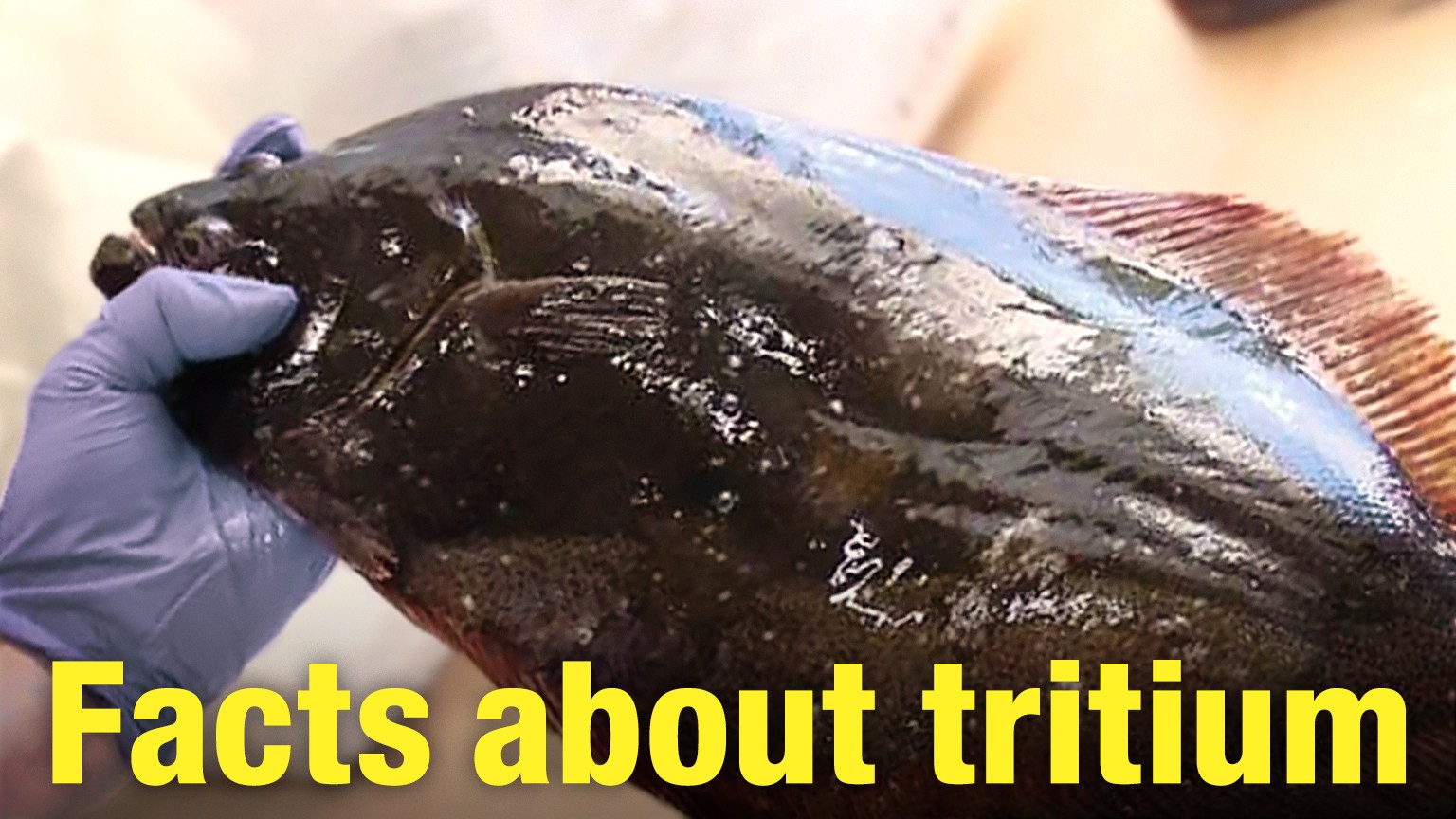Concerns remain that tritium in the water could bioaccumulate in living organisms, despite ample research showing that it does not.
The plant suffered a triple meltdown in the 2011 earthquake and tsunami. Water used to cool molten fuel at the plant has been mixing with rain and groundwater. The accumulated water is treated to remove most radioactive substances, but still contains tritium. Before the release, the operator dilutes the treated water to reduce tritium levels to about one-seventh of the World Health Organization's guidance level for drinking water.
Bioaccumulation is a process in which a certain substance in the environment accumulates within organisms as it is transferred through the food chain. It can leave an organism with several hundred thousand times more of the substance than normal.
In the case of marine life, this phenomenon occurs when a substance is first ingested by plankton, which are eaten by small fish, then larger fish, and so on.
NHK has interviewed scientists specializing in research on tritium and the effects of radiation, to find out why experts are not worried about tritium bioaccumulation.
What is tritium? Does it exist naturally?
Tritium is an isotope of hydrogen, sometimes denoted with the chemical symbol T. It emits beta rays that are so weak they cannot even pass through a sheet of paper.
Tritium is naturally present in water and human bodies always contain trace amounts of it.
Pure water consists of an oxygen (O) atom bonded to two hydrogen (H) atoms, so its chemical formula is H2O.
Instead of two hydrogen atoms, tritiated water — water that contains tritium — has one hydrogen atom and one tritium atom bonded to an oxygen atom. It is known as HTO. Removing tritium from tritiated water is technically difficult. Water containing tritium has chemical features almost identical to water with ordinary hydrogen.
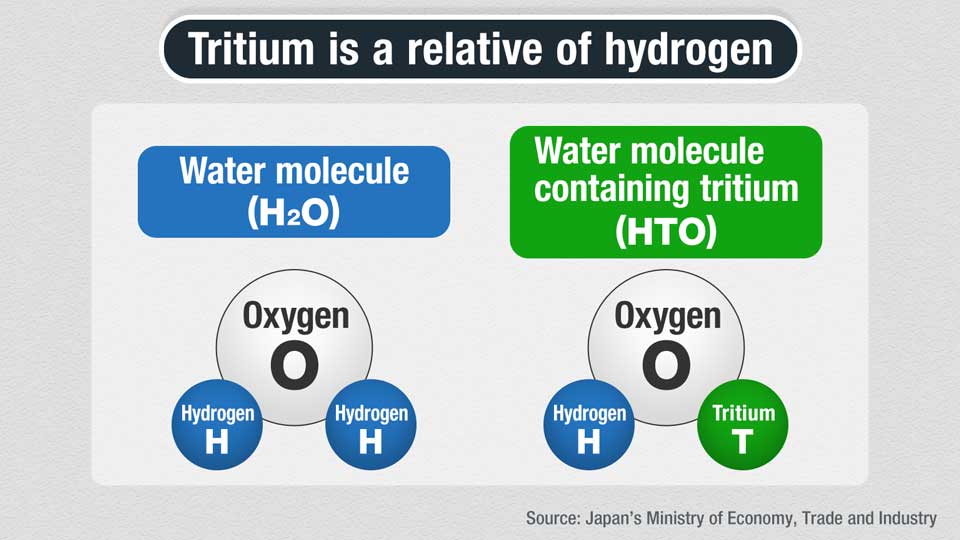
Does tritium bioaccumulate in the food chain?
When water is ingested by an organism, it circulates in the organism's body until it is excreted. The same is true for tritiated water: after being ingested by a human, fish, shellfish, or other organism, tritium is excreted relatively quickly and is not known to accumulate.
Torikai Yuji is a professor at Ibaraki University's Graduate School of Science and Engineering and is an expert on the properties of tritium.
"Studies conducted to date have not confirmed that ingesting tritiated water results in bioaccumulation," he says.
Torikai says that when humans ingest tritiated water, it spreads out evenly throughout the body's fluids within 24 hours. In about ten days, half of the ingested tritium will be excreted, and after a hundred days, only 0.1 percent of it will remain in the body.
Even if an organism continuously ingests tritium, it will also continuously excrete it, so the concentration in its body will never be higher than the concentration in the ingested water.
Torikai notes that tap water contains tritium.
"Even though people drink it for their entire lives, the tritium concentration in their bodies does not increase, and it does not accumulate to become concentrated," he says.
Even if the tritium concentration in fish may temporarily rise as a result of discharging the treated water, Torikai says that these concentrations will eventually return to the same levels as the surrounding environment.
"Tritium concentration in organisms is not expected to go above that level," he says.

Does some tritium linger longer?
One type of tritium binds to organic substances such as proteins in the bodies of living organisms. Known as organically bound tritium, it is excreted from the body more slowly than standard tritium.
According to Japan's Reconstruction Agency tasked with recovery from the 2011 disasters, organically bound tritium makes up 5 to 6 percent of the tritium contained in a human body.
The agency, as well as the Ministry of Economy, Trade and Industry, say most organically bound tritium ingested by the body is reduced by half within 40 days. Although it can remain longer and can take up to a year to be reduced by half, it is eventually all excreted.
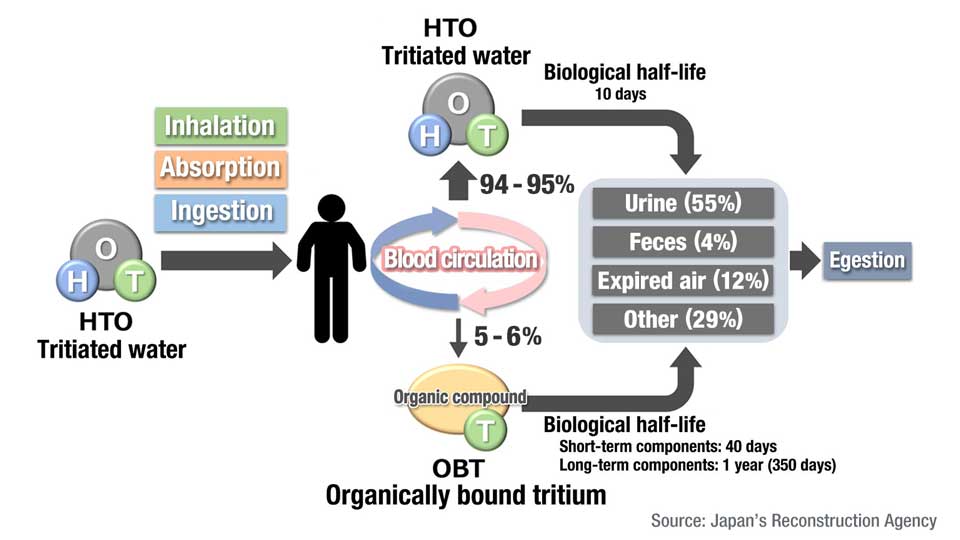
"Some people are concerned about organically bound tritium, but its concentration in fish will simply match the concentration in the environment where fish already live," Torikai says. "The current scientific consensus is that this substance will not reach concentrations beyond that of the sea."
Kai Michiaki, a professor at Nippon Bunri University's Department of Health and Medical Sciences, is an expert on the effects of radiation who serves on the International Commission on Radiological Protection. He says it is important to monitor fish to determine how much organically bound tritium they actually contain.
"Based on various data, at this point, I do not think that organically bound tritium is a very serious problem, but I think it is important to confirm this through monitoring and other means so that it can be stated as a reliable fact," Kai says.
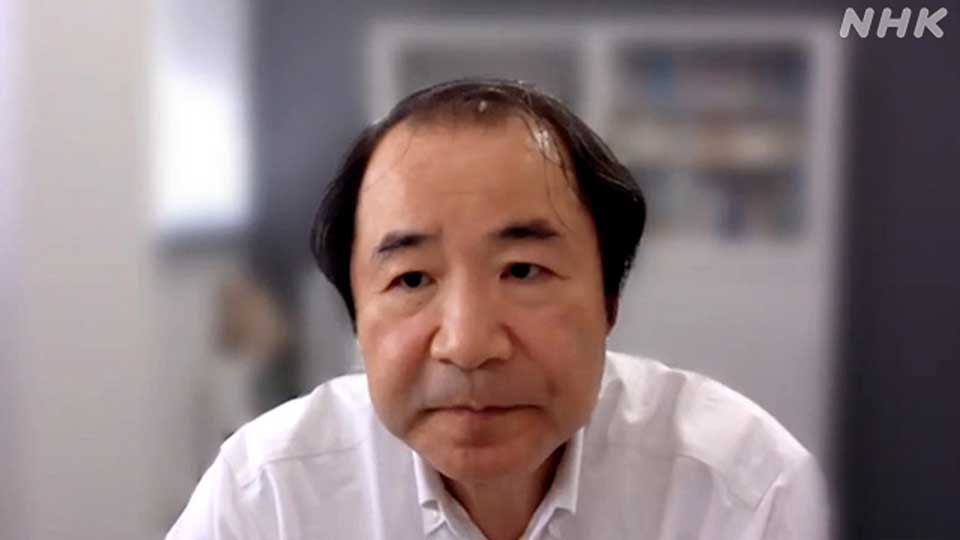
Are there any health effects?
When looking at the effects of radioactive materials on health, the crucial point to consider is the amount of radiation to which someone has been exposed.
If people receive a high dose of radiation, their genes can be damaged, raising their risks of cancer in the future.
Takamura Noboru, a professor at Nagasaki University's Atomic Bomb Disease Institute, is an expert on the effects of radiation on health. He also serves as the Director of the Great East Japan Earthquake and Nuclear Disaster Memorial Museum in Fukushima Prefecture.
Takamura says the treated water release is in line with current environmental standards and will not cause genetic damage.
The annual exposure limit for the general public as determined by international standards is 1 millisievert. The water discharged by TEPCO has a tritium concentration of less than 1,500 becquerels per liter.
"Even if you drank the water every day, your exposure dose would be lower than that of a chest X-ray," Takamura says.
He says the annual radiation exposure of drinking two liters of the treated and diluted water every day would add up to less than 0.1 millisievert. The risk of cancer observably increases above 100 millisieverts, so it would take more than a century of drinking the water daily to reach those levels.
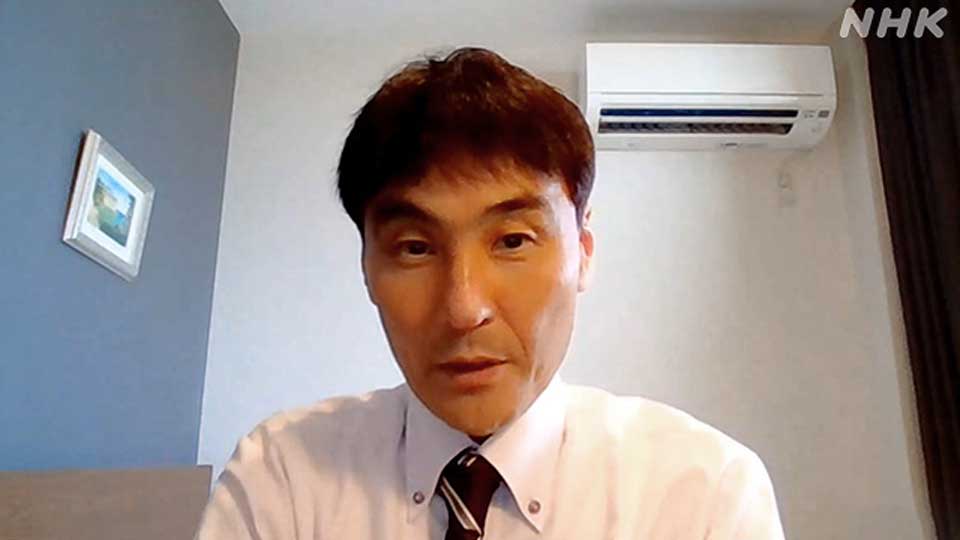
What do studies of fish show?
Since 2022, TEPCO has been conducting tests on marine organisms and breeding activity to determine how the treated and diluted water affects fish and other organisms.
In a test in which fish were raised in water with the same tritium concentration as the water being discharged, the concentration in their bodies did not increase above the level of their environment.
Japanese flounders were raised in an environment where the tritium concentration was less than 1,500 becquerels per liter, around the same concentration as the treated and diluted water released from the plant. The test results showed the concentration in the flounder's bodies did not exceed that level.
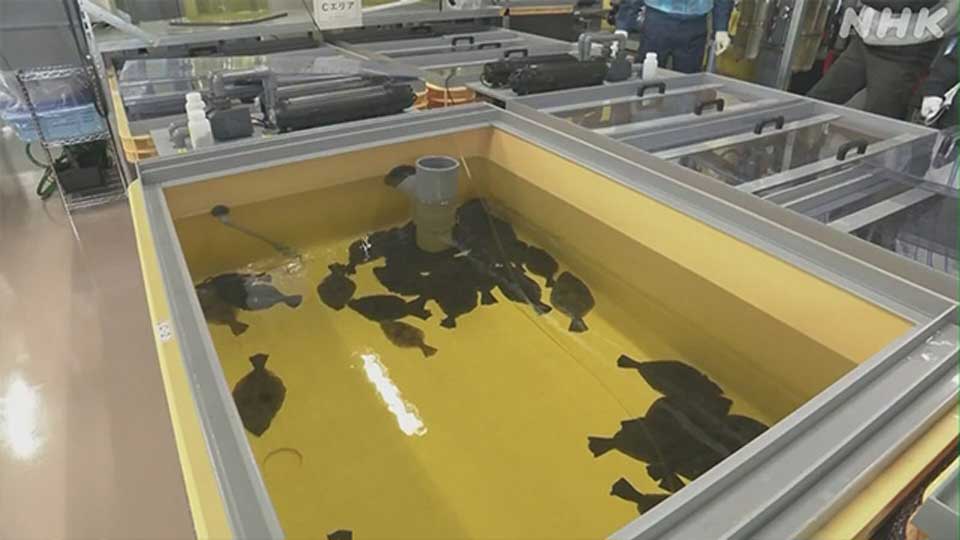
TEPCO says when the flounders were returned to normal seawater, their tritium concentrations decreased.
Japan's Fisheries Agency has been analyzing fish caught in the vicinity of the Fukushima plant on a daily basis. It says the concentration of tritium in these fish has remained below the minimum detectable level even after the water discharge began.
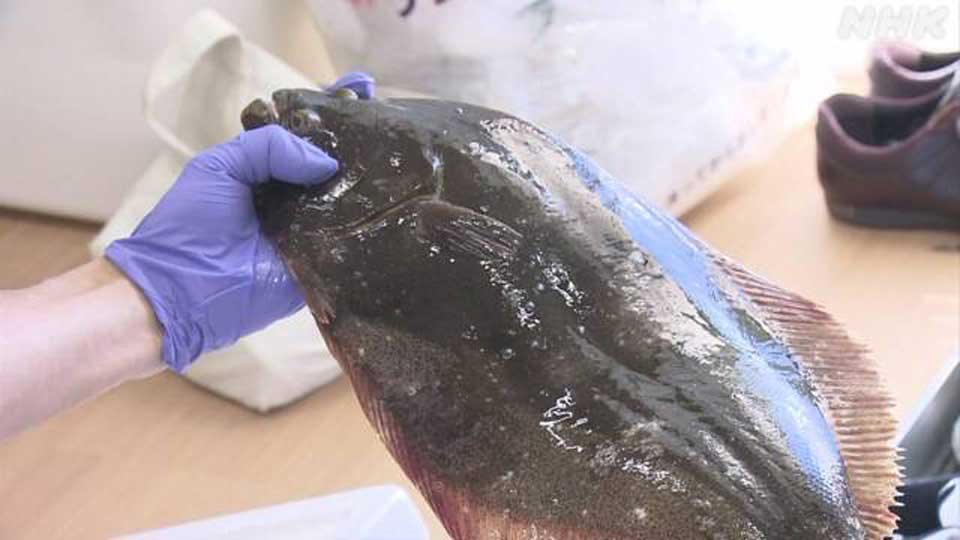
What about other radioactive materials?
In addition to tritium, the treated water contains a very small amount of other radioactive materials such as iodine-129 and carbon-14.
TEPCO says it has confirmed that the concentrations of radioactive materials other than tritium are below the safety standard set by Japan's nuclear watchdog, Nuclear Regulation Authority, even before it dilutes the water with seawater.
The operator says that if someone drinks two liters of this water every day for a year, they will be exposed to less than 1 millisievert of radiation throughout the year.
Before the treated water is discharged, its radioactivity is further diluted with seawater.
According to TEPCO's assessment in accordance with international guidelines, the impact of the discharge ranged from approximately .002 to .033 percent of a millisievert, depending on factors such as the amount of seafood the person consumes.
Ibaraki University's Torikai says that although some radioactive materials tend to accumulate in the body, the amounts are extremely small, so it is unlikely to have any effect.
"Even with all of the radioactive substances in the treated water, the radiation someone would be exposed to from drinking it every day would not exceed 1 millisievert per year, so it is considered safe," he says, adding, "Since the water is further diluted before it is released into the ocean, the concentrations of these radioactive substances and tritium are very low."
Nagasaki University's Takamura says even if the materials are ingested at those levels, "It is unlikely to cause health effects or damage to DNA."
Why is it crucial to address concerns?
Torikai says continuous measurement of radioactivity levels in fish is crucial to confirm that no tritium concentration is occurring.
"Verifying safety through measured data is important. Continuing to provide verifiable data is crucial," he says.
Nippon Bunri University's Kai acknowledges many distrust the government and TEPCO regarding the disaster, as they used to say before the accident happened that nuclear power plants were safe.
"In order to regain the trust of the people, I think it is necessary to provide accurate data and disseminate the objective facts. We should strive to grasp what we don't yet know and inform about that, too," Kai says.
Nagasaki University Professor Suzuki Tatsujiro, a former commissioner of the Japan Atomic Energy Commission and a nuclear policy expert, says the long-term effects of the radioactive materials other than tritium in the treated water must be monitored and studied.
Suzuki says that while it is important for the Japanese government to insist that the water is safe based on scientific evidence, just insisting may not be enough to regain credibility.
"I think the government and TEPCO should realize that there are a lot of people who are unsure about the treated water," he says, so action must include efforts "to understand what people are concerned about, how to respond to their concerns, and whether there are alternative measures that can be taken."
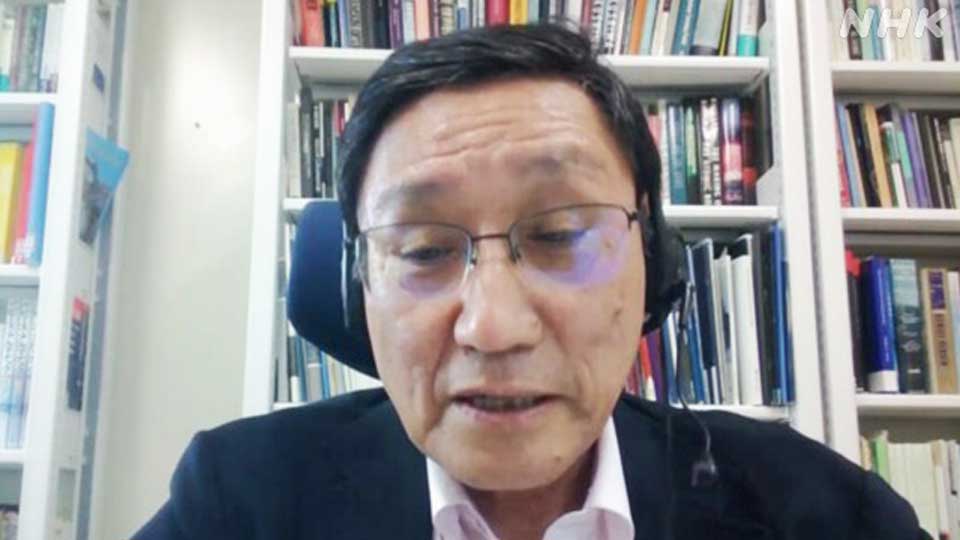
He says that if authorities believe that concerns are only due to a lack of explanations, "their project may not go well."
"For those who depend on the sea for their livelihood, discharging this treated water into the ocean is something that should only be considered as an absolute last resort," Suzuki says.
He adds that concerns naturally arise because people tend to have a visceral reaction to sensitive issues involving the food they eat, or radioactive materials.
Suzuki suggests establishing an independent body to verify that the comprehensive measures to decommission the Fukushima Daiichi Nuclear Power Plant follow acceptable standards. He says doing so would help build trust between the government and the people.
